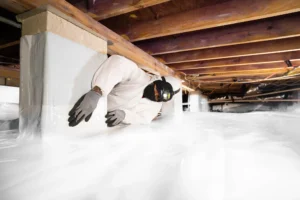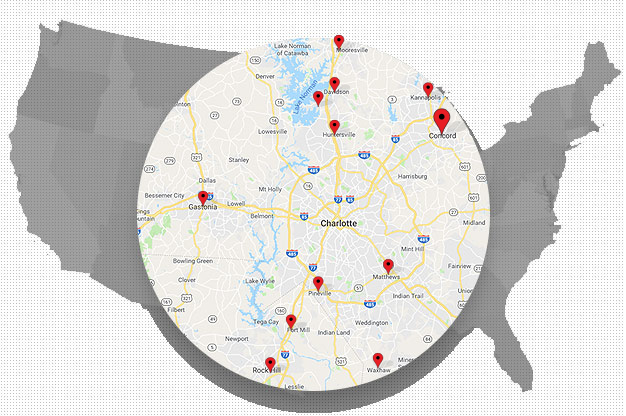Charlotte Crawl Spaces: 9 Early Warning Signs You Need Encapsulation (Before Mold Sets In)

Charlotte’s warm, muggy summers and periodic heavy rains keep crawl spaces under steady moisture pressure. That mix often drives humidity into the subfloor and wall cavities, where spores and pests thrive. Recent seasons across the Eastern U.S. have trended even stickier, which only raises the risk for untreated crawl spaces.
Encapsulation turns the crawl space into a controlled zone: a sealed vapor barrier, taped seams, closed wall vents, perimeter insulation, mechanical drying, and drainage where needed. Properly executed, it cuts off ground moisture, stabilizes humidity, and improves indoor air quality upstairs. Research in the Southeast, including North Carolina, shows that closed or conditioned crawl spaces manage moisture more reliably than vented ones.
Below are nine early warning signs that your crawl space needs attention before mold sets in.
Table of Contents
ToggleMusty odors drifting into living areas
A persistent earthy or musty smell signals microbial growth and excess moisture. Odor alone warrants investigation, since mold can produce allergens and irritants that affect occupants. Keep the nose test simple: if it smells damp on the first floor, the crawl space is likely sharing air with the house through the stack effect.
Relative humidity at or above 60 percent
Use an inexpensive hygrometer and check both the first floor and the crawl space. Sustained readings at 60 percent RH or higher set the stage for mold growth; targets between 30 and 50 percent are safer. Encapsulation plus a crawl space dehumidifier helps hold that line.
Condensation on ducts, pipes, or the sill plate
When warm, humid air reaches cooler metal or wood, water beads form. In vented crawl spaces, outdoor air with a higher dew point can drive this effect and dampen insulation. Crawl space encapsulation Charlotte reduces cold surfaces and limits humid air exchange, curbing condensation.
Cupping hardwood floors and sticky doors
Swollen floorboards and tight interior doors often originate below your feet. Wood absorbs vapor from damp crawl spaces, then expands. Persistent cycling like this invites wood rot and finish damage over time, another cue to address moisture at the source.
White, powdery deposits on foundation walls
That chalky film is efflorescence: salts left behind when water migrates through masonry and evaporates. It’s not just cosmetic; it’s a moisture roadmap showing where walls are wicking. Sealing soil and walls inside a sealed crawl space reduces vapor drive to those surfaces.
Rusting metal, loose hangers, or corroded fasteners
High humidity speeds corrosion on duct straps, nail plates, and pipe clamps. You may see reddish streaks, flaking, or a rough surface on metal parts. Corrosion inside a crawl space tends to spread and can weaken supports if moisture persists. (Combine this sign with others to confirm conditions.)
Insects and other moisture-loving pests
Moist wood and damp air draw termites, roaches, and camel crickets. Termites in particular seek wet or previously wetted wood; a humid crawl space gives them the conditions they need. Encapsulation dries the environment and removes that invitation.
Standing water or recurrent muddy soil
Pooled water after storms, or a chronically wet vapor barrier, points to drainage problems, plumbing leaks, or high groundwater. Surface grading, a French drain, and a reliable sump pump often accompany encapsulation to move water out and keep the liner dry.
More dust, allergies, or irritated sinuses indoors
Damp crawl spaces can move spores and particulates upward. While symptoms vary, many homes see calmer air once humidity below the floor is controlled and filtration is maintained. Drying the crawl space is a direct step toward mold prevention Charlotte in living zones.
Why encapsulation fits Charlotte homes
Charlotte’s climate loads the crawl space with moisture for months each year, so relying on passive venting rarely works. Closed or conditioned crawl spaces cut off ground vapor, reduce infiltration of humid outside air, and stabilize temperatures around ducts and framing. Field studies in the Southeast have documented better moisture control and added energy benefits when crawl spaces are closed and conditioned.
What an effective solution includes
A qualified team will inspect for leaks, set exterior drainage, and address structural issues first. Then comes the moisture control package: taped and anchored liner, continuous wall coverage, sealed penetrations, and controlled drying. In many Charlotte homes, crawl space waterproofing pairs with perimeter drains to route incoming water before it affects the liner. Keep indoor RH below 60 percent once the system is live to maintain a stable, humidity control baseline.
Quick reference: signs and next steps
| Early sign | What it signals | Typical next step |
|---|---|---|
| Musty odor upstairs | Active mold/moisture | Inspect, measure RH, plan encapsulation |
| RH ≥ 60% | Mold-friendly conditions | Seal, dehumidify, monitor |
| Condensation on ducts/pipes | Dew point issues | Close vents, insulate, condition |
| Cupped floors | Wood moisture cycling | Encapsulate; stabilize RH |
| Efflorescence on walls | Moisture wicking | Seal soil/walls; improve drainage |
| Rusting metal | High humidity | Reduce RH; replace corroded parts |
| Termite or pest activity | Damp habitat | Dry the crawl; treat as needed |
| Standing water | Drainage failure | Drains and pump with encapsulation |
| Allergy flare-ups | Air migration from crawl | Seal and filter |
When you recognize two or more of these signs, act promptly. Early encapsulation protects framing, keeps pests at bay, and supports healthier air. For homeowners planning upgrades, pairing encapsulation with targeted foundation repair often solves both moisture and structural concerns in one coordinated project.
Ready to stop chasing symptoms and fix the source? Schedule a professional crawl space assessment and request a design that prioritizes airtight sealing, managed drying, and proven drainage for long-term mold prevention in Charlotte.
Recent Posts
- Why Floors Feel Spongy or Bouncy After Heavy Rain (And What to Do About It)
- Basement Waterproofing ROI: The Value Boost Most Homeowners Must Know About
- Radon and Moisture Control in Charlotte: What Homeowners Need to Know
- Storm Aftercare: What to Do in the First 24 Hours of a Flooded Crawl Space or Basement
- Charlotte Crawl Spaces: 9 Early Warning Signs You Need Encapsulation (Before Mold Sets In)
Categories
- Basement Mold
- Basement Waterproof Foundation
- Basement Waterproofing
- Crawl Space Dehumidifier
- Crawl Space Encapsulation
- Crawl Space Encapsulation Cost
- Crawl Space Repair
- Crawl Space Waterproofing
- Crawl Space Waterproofing and Encapsulation
- Encapsulation
- Foundation Repair
- Foundation Waterproofing
- French Drains
- Leaky Basement
- Mold Remediation
- Mold Removal
- Radon
- Radon and Moisture
- Slab Jacking
- Sump Pump
- Uncategorized
- Vapor Barrier
- Water Leak
- Waterproofing
- White Mold
Archives
- October 2025
- September 2025
- August 2025
- July 2025
- June 2025
- March 2025
- August 2024
- June 2024
- May 2024
- March 2024
- January 2024
- June 2023
- May 2023
- April 2023
- March 2023
- February 2023
- January 2023
- December 2022
- November 2022
- October 2022
- September 2022
- August 2022
- July 2022
- June 2022
- May 2022
- March 2022
- February 2022
- January 2022
- December 2021
- November 2021
- October 2021
- September 2021
- August 2021
- July 2021
- June 2021
- May 2021
- April 2021
- March 2021
- February 2021
- January 2021
- December 2020
- November 2020
- October 2020
- September 2020
- August 2020
- July 2020
- June 2020
- May 2020
- April 2020
- March 2020
- February 2020
- January 2020
- December 2019
- November 2019
- October 2019
- September 2019
- August 2019
- July 2019
- June 2019
- May 2019

